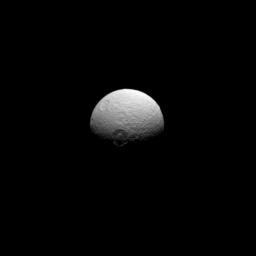
|
Melanthius at Dusk
- Click the image above for a larger view
- Full-Res JPEG (833 x 833) (13.6 kB)
- Full-Res TIFF (833 x 833) (694.9 kB)
Caption:
The craters of Tethys tell the story of a violent history marked by impacts. The names of the craters also tell oft-violent stories: in this case, the Iliad and the Odyssey . Here, we see the craters Melanthius (near the center, at the day/night terminator), Dolius (above Melanthius), and Penelope (upper left almost over the limb). Penelope was the faithful and wise wife of the Greek hero Odysseus, Dolius was their loyal gardener, and Melanthius was Dolius' son.
This view looks toward the leading side of Tethys. North on Tethys is up and rotated 32 degrees to the right. The image was taken in visible light with the Cassini spacecraft narrow-angle camera on May 16, 2013.
The view was obtained at a distance of approximately 684,000 miles (1.1 million kilometers) from Tethys and at a Sun-Tethys-spacecraft, or phase, angle of 63 degrees. Image scale is 4 miles (7 kilometers) per pixel. The image has been zoomed in by a factor of 1.5.
Background Info:
The Cassini-Huygens mission is a cooperative project of NASA, the European Space Agency and the Italian Space Agency. The Jet Propulsion Laboratory, a division of the California Institute of Technology in Pasadena, manages the mission for NASA's Science Mission Directorate, Washington, D.C. The Cassini orbiter and its two onboard cameras were designed, developed and assembled at JPL. The imaging operations center is based at the Space Science Institute in Boulder, Colo.
For more information about the Cassini-Huygens mission visit http://saturn.jpl.nasa.gov and http://www.nasa.gov/cassini . The Cassini imaging team homepage is at http://ciclops.org .
Cataloging Keywords:
| Name | Value | Additional Values |
|---|---|---|
| Target | Tethys | |
| System | Saturn | |
| Target Type | Satellite | |
| Mission | Cassini-Huygens | |
| Instrument Host | Cassini Orbiter | |
| Host Type | Orbiter | |
| Instrument | Imaging Science Subsystem (ISS) | |
| Detector | Narrow Angle Camera | |
| Extra Keywords | Crater, Grayscale, Impact, Rotation, Visual | |
| Acquisition Date | ||
| Release Date | 2013-11-04 | |
| Date in Caption | 2013-05-16 | |
| Image Credit | NASA/JPL-Caltech/Space Science Institute | |
| Source | photojournal.jpl.nasa.gov/catalog/PIA17138 | |
| Identifier | PIA17138 | |
